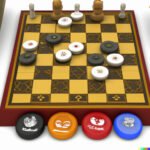In the vast world of board games, few have withstood the test of time and captivated players for generations quite like the Battleship Classic Board Game. With its strategic gameplay and exhilarating naval battles, Battleship has become a household name synonymous with thrilling competition. But where did this beloved game originate? In this article, we will dive into the rich history of Battleship, shedding light on its origins and how it has evolved over time.
Dating back to the early 20th century, Battleship emerged as a pencil-and-paper game known as “Broadsides”. It quickly gained popularity among naval officers and soldiers as a way to pass the time during long voyages and dull days at sea.
The concept was simple yet engaging – players would draw their fleet of ships on their own grid paper and take turns trying to guess the location of their opponent’s vessels. A hit or a miss would ultimately determine who emerged victorious in these thrilling maritime duels.
Fast forward to 1967 when Milton Bradley Company released “Battleship”, a plastic board game adaptation that revolutionized the way people played. This version featured plastic grids and small model ships that could be placed strategically on each player’s ocean board.
The action intensified as players called out coordinates and launched attacks with miniature missile pegs, eagerly awaiting their opponent’s response. Over the years, numerous editions and variations have been released, from electronic versions to travel-sized boards, ensuring that Battleship remains accessible to players of all ages.
The enduring appeal of Battleship lies not only in its entertainment value but also in its ability to cultivate strategic thinking and problem-solving skills. As players meticulously plan each move, they must consider various tactics such as ship placement, camouflage strategies, and decoy operations. Through playing Battleship, individuals learn valuable lessons about decision-making under pressure while honing their ability to foresee outcomes based on limited information.
So join us on this historical journey as we uncover the fascinating story behind Battleship and how it has grown to become a beloved classic among board game enthusiasts. From its humble origins to its impact on popular culture, we will explore all facets of this iconic game and reveal what makes Battleship truly timeless.
How to Play Battleship
Playing Battleship is a fun and strategic game that has been enjoyed by players of all ages for decades. In this section, we will provide you with a step-by-step guide on how to play Battleship, perfect for beginners who are just starting their naval warfare journey.
Setting Up the Game Board
To begin, each player will need their own game board. The game board consists of two grids labeled with letters along the top and numbers along the side. One grid represents your own fleet while the other grid represents your opponent’s fleet. It is important to arrange your ships strategically on your own grid without letting your opponent see.
Placing Your Ships
Each player will have a fleet of five ships: an aircraft carrier (5 spaces), a battleship (4 spaces), a submarine (3 spaces), a destroyer (3 spaces), and a patrol boat (2 spaces). The objective is to hide these ships on your grid in various positions while keeping them secret from your opponent’s view.
To place your ships, start by selecting one ship at a time and deciding upon its position on the grid. You can choose either a vertical or horizontal orientation for each ship. Make sure to leave some space between each ship so they do not touch each other horizontally, vertically, or diagonally.
Taking Turns and Calling Out Shots
Once both players have set up their fleets, the game can begin. Players will take turns calling out coordinates on the opponent’s grid to target their ships. For example, “B6” would refer to row B and column 6 on the opponent’s grid.
If you hit an enemy ship, mark it as “hit” by placing a red peg in that coordinate on your opponent’s grid. If you miss, mark it as “miss” with a white peg. The aim of the game is to sink all of your opponent’s ships before they sink yours.
Now that you have a basic understanding of how to play Battleship, grab a friend or family member and get ready to engage in an exciting battle on the high seas. Remember, strategy and careful planning are key to victory in this classic board game. Good luck.
Strategies and Tactics to Dominate in Battleship
Battleship is a classic board game that requires strategic thinking and clever tactics to outmaneuver and defeat your opponent. In this section, we will explore some expert tips and strategies to help you dominate in Battleship.
One key strategy in Battleship is to spread out your ships across the board. Placing them too close together makes it easier for your opponent to locate and sink them. By spreading out your ships, you increase the chances of your opponent missing their shots and wasting their turns. Additionally, it’s important to place each ship strategically, considering factors such as positioning them near corners or edges of the board where they are less likely to be targeted.
Another effective tactic in Battleship is to track and analyze your opponent’s moves. Pay attention to areas where they frequently target or patterns in their approach. This information can give you valuable insights into their ship placements and help you plan your attacks more effectively. Likewise, try to throw off your opponent by making unpredictable moves that make it difficult for them to guess the location of your ships.
Communication is also crucial in Battleship if you are playing with a teammate. Effective coordination and clear communication can help prevent overlapping or wasted shots on the same target. Develop a system or code words with your teammate that indicate which areas have been covered or suspected ship locations.
| Strategy | Description |
|---|---|
| Spread Out Ships | Place ships at different areas on the board. |
| Track Opponent’s Moves | Pay attention to patterns and targeted areas. |
| Effective Communication | Coordinate with teammates and avoid overlapping shots. |
The Evolution of Battleship
The Rise of Digital Adaptations
In recent years, the classic board game Battleship has undergone a major transformation with the advent of digital adaptations. The rise of technology and the increasing popularity of online gaming platforms have allowed players to experience Battleship in a whole new way. Whether it is through computer software, mobile apps, or online multiplayer platforms, the digital adaptations bring a fresh and modern take on this timeless game.
Benefits of Digital Adaptations
There are several benefits to playing Battleship in its digital form. One of the most obvious advantages is the convenience and accessibility that comes with being able to play anytime and anywhere. With just a few clicks or taps, players can engage in battles against opponents from all around the world without ever leaving their homes.
Additionally, digital adaptations often come with enhanced graphics and sound effects that enhance the overall gaming experience. For example, players may enjoy realistic naval animations as ships sink after successful strikes or explosive sound effects that heighten the thrill of gameplay. These visual and audio enhancements add an extra layer of excitement to Battleship, making it even more captivating for both new and seasoned players.
Furthermore, digital adaptations often provide players with additional features that are not available in traditional board games. For instance, some versions may offer different game modes such as single-player challenges or various difficulty levels to cater to different skill levels. These added features not only make Battleship more dynamic but also prolong the enjoyment and engagement for players who are looking for something beyond the traditional gameplay experience.
The Psychological Aspects of Battleship
Battleship is not solely a game of luck and chance; it also requires strategic thinking, deduction, and psychological skills to outsmart and outmaneuver your opponent. In this section, we will delve into the psychological aspects of Battleship and explore strategies that can give you the upper hand in the game.
One key psychological aspect of Battleship is bluffing. Since players take turns guessing the coordinates of their opponent’s ships, it is essential to create doubt and confusion in their minds. By intentionally making false guesses or placing ships in unexpected locations, you can deceive your opponent and force them to waste turns searching in the wrong areas. Bluffing requires careful consideration of your opponent’s thought process and an understanding of how they may perceive your moves.
Another important psychological aspect is reading your opponent’s behavior and reactions during gameplay. Pay attention to their facial expressions, body language, or any subtle cues they may give when you hit or miss their ships. These cues can provide valuable information about the location of their ships or their general strategies. By observing and interpreting these signals correctly, you can make better-informed guesses and target their ships more effectively.
Moreover, a disciplined mindset is crucial in Battleship. It can be frustrating when your ships are continuously being sunk, but giving in to frustration can cloud your judgment. Staying calm and focused enables you to think strategically even under pressure. Recognizing patterns or identifying potential weaknesses in your opponent’s strategy becomes easier when you maintain a clear mind.
In summary, mastering the psychological aspects of Battleship can give you an advantage over your opponents. Bluffing, reading your opponent’s behavior, and maintaining a disciplined mindset are all essential tactics to outsmart and outmaneuver them. Incorporating these skills into your gameplay will greatly improve your chances of winning battleships games.
| Psychological Aspects | How to Apply |
|---|---|
| Bluffing | Make false guesses and place ships in unexpected locations to deceive your opponent. |
| Reading Opponent’s Behavior | Observe facial expressions, body language, and other cues to gain information about their strategy. |
| Disciplined Mindset | Maintain a calm and focused mindset to think strategically even under pressure. |
Famous Battleship Tournaments and Championships
Battleship, the classic board game, has evolved from a simple pastime into a competitive activity enjoyed by enthusiasts around the world. Over the years, numerous tournaments and championships have been organized, giving skilled players the opportunity to showcase their strategy and tactical prowess. In this section, we will explore some of the famous Battleship tournaments and championships that have taken place.
One notable tournament is the World Battleship Championship, which attracts participants from various countries. This championship follows a structured format where players compete against each other in elimination rounds. The winners of each match advance to the next round until a final champion is crowned. Participants in these tournaments display exceptional skills in targeting their opponent’s fleet while strategically protecting their own ships.
Another popular event in the world of competitive Battleship is the National Championships held annually in different countries. These championships gather top-level players who have qualified through regional tournaments or by invitation based on their skill level. The intensity of these competitions can be overwhelming as players must quickly adapt to different opponents’ styles and execute effective strategies to prevail.
In recent years, online Battleship championships have become increasingly prominent. These virtual tournaments offer convenience for participants located in different parts of the world and provide an opportunity for players to compete against opponents globally. Online platforms host regular competitions where players can test their skills against a diverse range of opponents, challenging themselves to improve their gameplay.
Whether it be through traditional face-to-face competitions or virtual battles on digital platforms, Battleship tournaments and championships continue to captivate both casual players and dedicated enthusiasts alike. These events not only showcase high-level gameplay but also foster strong communities that share a mutual love for this strategic board game.
Battleship as a Teaching Tool
Playing board games can be not only entertaining but also educational, and Battleship is no exception. This classic board game offers numerous educational benefits that make it an ideal teaching tool for both children and adults.
One of the main educational benefits of playing Battleship is the development of critical thinking skills. The game requires players to think strategically, analyze their opponent’s moves, and make logical deductions based on available information. Through this process, players learn to think ahead, anticipate their opponent’s actions, and adapt their strategies accordingly. This kind of critical thinking fosters problem-solving abilities that can be applied in various academic and real-life scenarios.
Furthermore, playing Battleship can improve spatial reasoning skills. In order to accurately guess the location of their opponent’s ships, players must visualize the grid and mentally track potential coordinates. This spatial reasoning promotes mental visualization and the ability to manipulate objects within an imaginary space. These skills are valuable in subjects such as mathematics, engineering, architecture, and even art.
Additionally, Battleship helps improve communication skills as it requires players to effectively convey information while trying to mislead their opponents. Players must use clear language and concise directions to describe their guesses or responses without giving away too much information about their own ships’ positions. This enhances verbal communication skills and teaches players how to articulate their thoughts in a precise and strategic manner.
Overall, by incorporating Battleship into lesson plans or educational activities, educators can foster critical thinking, spatial reasoning, and communication skills among students in a fun and engaging way. Moreover,the interactive nature of this classic board game encourages social interaction among players which further enhances collaborative learning experiences.
Some ways educators can utilize Battleship as a teaching tool include organizing tournaments or competitions between students that require them to apply different strategies or have structured discussions about tactics employed during gameplay. By recognizing the educational value of classic board games like Battleship, educators can create an engaging and interactive learning environment that nurtures important skills for academic success and beyond.
The Cultural Impact of Battleship
In conclusion, the cultural impact of Battleship has been far-reaching and influential. From its early origins as a classic board game to its adaptations into digital formats, Battleship has remained a beloved part of popular culture. Not only has the game sparked famous tournaments and championships, but it has also served as an educational tool for teaching strategic thinking and problem-solving skills.
One notable aspect of Battleship’s cultural impact is its presence in various movie adaptations. The 2012 film “Battleship,” directed by Peter Berg, brought the game to life on the big screen with a thrilling storyline involving an alien invasion. While the film received mixed reviews, it undeniably expanded the game’s visibility to audiences around the world.
Moreover, Battleship has also made numerous appearances in pop culture references throughout music, television shows, and literature. It has become synonymous with strategy and competition, appearing in iconic TV series such as “Friends” and inspiring countless song lyrics. This widespread recognition of Battleship demonstrates its enduring influence on contemporary culture.
In summary, Battleship is more than just a classic board game. Its cultural impact can be seen in the multiple mediums it has infiltrated – from movies to pop culture references. Additionally, its presence in competitive scenes and use as an educational tool further speaks to its lasting legacy. As technology continues to advance, it will be interesting to see how Battleship adapts and evolves in the future while remaining a timeless favorite among players old and new alike.
Frequently Asked Questions
What Is the Original Battleship Game?
The original Battleship game is a strategy board game that was first published in 1967 by the Milton Bradley Company. The game revolves around two players who each have their own grid boards and an equal number of ships placed on them.
The objective of the game is to strategically guess and locate the opponent’s hidden ships by calling out coordinates on the grid. The first player to successfully sink all of their opponent’s ships wins the game.
How to Play Battleship Classic?
Playing Battleship Classic involves both players setting up their fleet of ships on their respective grid boards, which are typically divided into numbers and letters for easier reference. The size and quantity of ships vary depending on the version played, but they generally include a carrier, battleship, cruiser, submarine, and destroyer. Players take turns calling out coordinates (e.g., B4) to try and hit their opponent’s ships.
If a ship is hit, the opposing player must announce “hit” or “miss” accordingly. A red peg is used to mark hits on the target ocean grid and a white peg marks misses. By using strategic thinking and deduction, players attempt to sink all of their opponent’s ships before their own fleet is destroyed.
What Age Group Is Battleship For?
Battleship can be enjoyed by a wide range of age groups. While it may seem like a classic game targeted more towards older individuals due to its historical origins, Battleship can still engage younger players as well.
In terms of specific age group recommendations, Battleship is typically suitable for children aged 7 years old and above due to its basic gameplay mechanics and requirement for logical thinking skills. That being said, older children, teenagers, adults, and even seniors can find enjoyment in this timeless game as it offers strategic depth and requires critical thinking abilities from its players.

I love playing all kinds of games – from classics like Monopoly to modern favourites like Ticket to Ride.
I created this blog as a way to share my love of board games with others, and provide information on the latest releases and news in the industry.





